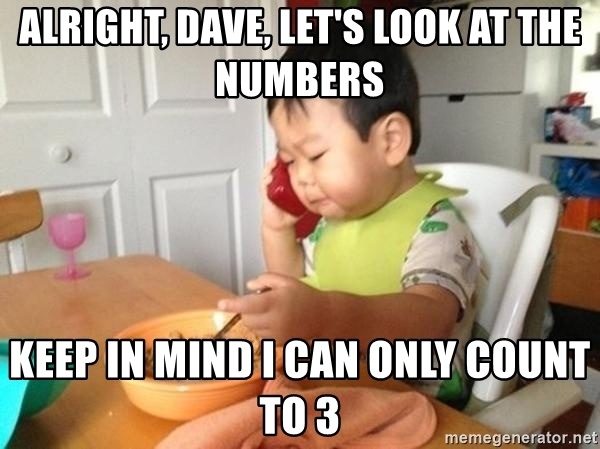The beginning of the year is always a good time to do a year in review of the last year — what went well, what could have been better.
Here in The No Pants Project, we’re on a mission to help as many people as possible build profitable freelance businesses that give them freedom – financially, mentally, physically, you name it.
Achieving this type of business comes down to some core principles: simplicity, serving, and savoring your freedom to design, build and run whatever type of business makes you happiest.
To show this in action, Mike Shreeve shared how he got The No Pants Project to that coveted 7-figure status by the end of 2018, and what he learned along the way.
For those who missed the podcast episode, we’ve pulled out 28 key takeaways you can apply to your own business ambitions – or just use to give yourself permission to dream a little bigger.
 (Source: www.cbaugh.files.wordpress.com)
(Source: www.cbaugh.files.wordpress.com)
1. Analysis is critical.
Take honest stock of your situations (financially, mentally, physically, etc.) and plan your actions from there, instead of just reacting to whatever comes each day.
It’s pretty hard to get where you want to go if you’re not sure where you are currently.
You can have a map outlining every twist and turn you need to take on your journey, but that map is useless if you don’t know where you are along the route, or even where you are relative to the path, should you currently be lost in the wilderness.
The first step of any successful journey isn’t the actual first step you take, it’s determining where you are relative to where you want to go, so you can plan the route.

For example, later in the podcast when Mike talks about hiring mistakes (point 16), he talks about how he could only fix it once he examined his hiring process and realized he was relying on a potential hire’s experience to decide whether they could deliver on their promises, instead of doing the work to properly vet their past work and delivered results.
Once he determined the problem, he was able to use his found solution to hire better team members who could actually help him reach his goals.
Here at NPP we include a process for figuring out both where you are right now and where you want to go, as well as providing the route connecting them.
Yeah, we’re overachievers like that.
2. Learn the lessons you’ve paid for – the first time.
Every mistake you make or dollar you spend has something to teach you, especially (but not exclusively) within the context of your business.
Staying alert and thinking through the consequences and results you achieve with your time, money, and energy, is critical for figuring out where your investments are best directed.
For example, in the previous point we talked about how Mike solved his hiring problems by analyzing where he was going wrong in order to fix the process and hire better team members.
However, if Mike had done this sooner, he wouldn’t have had to pay for the same lesson multiple times, and the cost of learning that lesson would have been substantially less, financially and mentally.
3. Build your income streams one at a time.
In the beginning, you absolutely do need to test multiple markets to find the one that responds best to you and your business idea.
If you find more than one, you might be tempted to work on multiple opportunities at a time to provide a safety net for yourself.
However, if you try to build two or three different businesses at once you’re just multitasking on a larger scale, and we all know that multitasking for productivity is actually a myth.
Zac Carman, CEO of ConsumerAffairs, shares the dangers of wearing too many hats as a business leader and warns, “Every time I switched tasks, my IQ level was dropping up to 15 points, which is three times more than the effects of smoking marijuana. Multitasking makes people less productive, less creative and more likely to get thrown off task by distractions.”
It takes concentrated time and effort to work through the growing pains, kinks, and system development that allow you to build a successful business.
Until your business can run without your constant oversight, starting another is actually more likely to make you fail at both because it splits your focus, commitment, and ability to establish solid foundations.

4. Income that is projected is not guaranteed income.
This is a classic “don’t count your chickens before they hatch” scenario, but you would be shocked by the sheer number of people who bend these truths for the sake of their ego or their marketing.
Signing a $100,000 contract paid in 10 monthly payments of $10,000 dollars is not the same as receiving a $100,000 check.
Until those payments are squared away, you haven’t made six figures.
Instead of holding out for big contracts, break your income goals down into smaller, more achievable client and project goals.
We suggest that to make $10,000 a month, you should plan and look for 5 clients willing to pay you $2,000 each month, then earn retainer contracts to stabilize your income and reduce client churn.
5. A 7-figure business is still very small in the grand scheme of things.
Every millionaire is just a person, and it’s important to remember that on both sides of the fence.
A dream of making it into 7-figure status is attainable because every millionaire is still just a person, so don’t be afraid to dream bigger.
To make it feel more achievable, you could break a million dollar income goal down into the required sales based on your service or product price.
If you have a $1,000 product, you need to sell 1000 units in a year, which is 83 units a month, or just the even more reasonable 20 units a week.
If your product is $100, that works out to 10,000 units a year, 830 units a month, or 200 units a week.
Once you sell those 20 or 200 units a week though, remember that making it to 7-figure status does not make you better than anyone who hasn’t yet.
You’re just on the other side of the execution plan now, so don’t let your ego swell.
6. You don’t need to take out loans to start a lucrative business.
In fact, here at NPP we are big proponents of never borrowing to start a company (for reasons we’ll get into a little further down the list).
Mark Cuban, noted serial entrepreneur and panelist on Shark Tank, even goes so far as to say that, “If you’re starting a business and you take out a loan, you’re a moron, because there are so many uncertainties involved with starting a business yet the one certainty you’ll have to have is paying back your loan.”
So keep in mind that you don’t start at big numbers, you work your way up.
The speed of how fast you can build up to your goals is dictated by how much you’re willing to risk through reinvestment.
Your growth will be exponential as you learn and reinvest.
7. Losing money is not the same as wasting money.

You will lose money while growing your business – nobody is perfect and mistakes will always be made.
But the fewer risks you’re willing to take, the fewer rewards you’ll reap.
CNBC reports, “Often, especially in the early days of new companies, losing money is part of the plan. Amazon, now a mature technology giant but long known for not worrying about short-term financials, last week announced a 77 percent decline in second-quarter profit as it invests heavily in video content and global expansion.”
Building a business is similar to skills-based gambling, where the better you are at making decisions with the information you have, and not getting stuck on the risk, uncertainty, or short-term learning curves, the better off you’ll be.
Our points above, notably point 1 (analysis is critical) and point 2 (learn your lessons the first time), are the guideposts Mike uses to approach his business decisions from a testing and revising perspective rather than a success/failure paradigm.
Ann Latham, expert on strategic clarity and author of The Clarity Papers, shares her tips for getting unstuck, writing, “If you are still stuck, I suspect you are mired in risk or uncertainty. Challenge your assumptions about what must or might happen in various scenarios. Don’t generalize. Broad risks and worries shrink to manageable issues when you get specific.”
After that it’s just about readily adjusting to inevitable changes and feedback.
8. You can’t do this alone.
Part of your reinvesting strategy should always include outsourcing whatever tasks eat up the largest chunks of your day or mental energy, leaving yourself only the tasks that your involvement is essential in.
Fair warning: it’s probably going to feel like it’s essential to do everything yourself.

This is only true in the very beginning of your business, as you are learning your lessons, doing your research, and bootstrapping your growth.
Then, you will need to invest in people AND advertising to keep scaling.
A great example of this is the way Mike used his investments in The No Pants Project to make the program even more enticing by advertising the coaches he hired on to help him as a major benefit of the program.
That allowed him to attract and help more people at once, more consistently.
Without the coaches he hired to help, Mike couldn’t help as many freelancers and he wouldn’t have been able to build trust and faith in the program to the same degree that a dedicated, expanding team of coaches allows him to do now.
For your own business, start small by hiring a VA or creating a system to do simple tasks that distract from more important, fulfilling parts of your business.
If you’re not there yet, enlist the help of your spouse or family to take care of housework and external distractions that don’t recharge you or help you de-stress.
9. The most dangerous number in business is one.
This speaks to what we talked about back in number 4 (projected income is not income) but goes a step further.
Maybe your chickens have all hatched now, but if you haven’t built them a pen and a fence, you might start losing them to the foxes or regular chicken shenanigans (like climbing trees).
Also, if you’re relying on four chickens to lay four eggs every day, it’s quite possible one chicken is just going to have one of those days and lay nothing.
Mike talks about this particularly in reference to his fiction publishing business, where he decided to always maintain an alternate income stream because he recognized that his fiction business is directly dependent on Amazon, which is something he cannot control.
As a freelancer, you can’t control other people or businesses, so never rely on one client to produce all your revenue, or on one traffic stream to deliver all your leads.
10. Test everything.
The first year of any good business is all about testing.
Figure out what works and what doesn’t.
What is your audience willing to buy?
What do they want?
What do they definitely don’t want?
What makes your service unique?
This doesn’t mean you aren’t profitable during this time, it just means that Year One = Controlled Chaos.
After that, you use the data you’ve gathered to pare down to the most profitable, purposeful components of your business so far and transition into scaling up using systems that allow you to work less.
With The No Pants Project, Mike spent the first year and half developing and testing more than 10 products and programs to gauge what his market really wanted and responded to.
As a result, in 2019 he knows his market and can focus on only the best of his offerings to maximize the value for everyone involved.
11. Expect chaos, but don’t confuse chaos for overworking.
Chaos is question marks, high churn, uncertainty of whether something is going to work or not, and lots of deadlines.
It’s not working 80-100 hour weeks, living on Red Bull, and ignoring your family and friends while you work on your business, going crazy from stress and burning out before the year is up.

The “hustle mentality” is not something you need to be successful, regardless of what the so-called “gurus” are teaching in their corners of the interwebs.
Jayson DeMers, Founder and CEO of AudienceBloom, talks about the diminishing returns of working more hours and concludes:
“Hard work is not a bad thing and there is nothing wrong with being proud of the hours you work and the effort you expend. The danger is prioritizing the amount of work you do rather than the quality of work you do and your health.”

12. When you’ve made a mistake, you’ve already done 80% of the work toward creating a success.
When things don’t go right, there is gold is to be found.
Those are the instances that give you cold, hard, glorious data you can use to adjust and repurpose the assets you’ve already built.
“Success and failure are the same. They are both results. Look at your results closely. They’re telling you how well your approach is working,” Frank McKinley, creative coach for writers, reminds us.
A failure doesn’t mean you need to rebuild from the ground up or go back to the drawing board.
It means that if you pivot according to what you learned, you’re that much closer to creating the success you’re looking for.

13. Popular does not equal profitable.
The fastest way to run a business into the ground is to build it trying to please people who were never going to buy.
If someone doesn’t like you, that’s great – they’ve disqualified themselves as a lead and you can focus on serving the people who are actually looking for the help you offer.
It’s a waste of money to chase Joe Schmoe and try to convince him to give you his money and internet esteem.
Instead, get feedback from people who are responding positively or with reasonable objections, instead of people responding with snarkiness, troll speak, and potential Short Guy Syndrome.
If you’re afraid to sell to your audience, you don’t have a business.
Lisa Larter, business coach for entrepreneurs writes, “Your fear of rejection is the number one reason why your business is not growing the way you want it to financially.”
Instead of letting your personal fear of rejection let you build your business around popularity, remove yourself and your ego from the equation and do what is best for your business and the people you are trying to help.
That means offering to help them and showing them how to get that help at every turn.
14. Don’t build a business to fit a model, build it to serve.
Here’s the thing about the way we teach in The No Pants Project: we’re giving you quality advice based on wisdom gained through doing things the hard way ourselves.
But, it is still just advice.
If something we advise in our programs doesn’t work for you, don’t do it.
Find something that does work for you, and, just as importantly, your clients.
For example, just this last year, Mike said he made the mistake of launching the No Pants Academy based on a model someone told him he should be following – and it was a big flop.
Why?
Mike said, “I just created that program because someone told me I needed a program like that in our business. I didn’t build it with the intention of, “How can we serve at a deep level in a way where people can just pay us smaller monthly amounts rather than big thousand dollar up front fees?” I ashamedly admit that. Sometimes you think, “Well, I have to do it because that’s what people tell me to do.” New business models thrive all the time! Don’t do things just because it fits someone’s diagram online.”
The next go around we won’t make that mistake and we hope that by sharing, you won’t either.
15. Don’t build a business based on volume.
People pay for what serves them.
As long as they feel that the money they give you is less than the value they gain, they’ll keep paying you.
As soon as that’s not the case, they’ll stop.
If you’re counting on loyalty or constantly attracting new customers, when you can’t hold on to the ones you have, you’re going to wind up in a bad place pretty fast.
The Business Dictionary reminds us, “If your product becomes known for its shoddy construction – and due to the Internet, word travels fast – your overall sales will be quickly damaged. If your product is too cheap, it can also get easily lost in the bargain bin [..] alongside a plethora of shoddy, similar [..] products.”
And that goes for services too. The more value you give to each person you encounter, help, and serve, the better your business will be and the more profitable it will become.
Instead of asking what more you could sell to people or how to get more people to buy your products, ask how you could better serve your audience and niche, and let your shining reputation sell for you.
16. When hiring, actions DO speak louder than words.
It’s unrealistic to assume that you’ll never hire someone who turns out to be less than desirable.
But if everyone you’re hiring is letting you down, you’re probably hiring based on talk, and talk is cheap.
Vet your potential hires and help properly by finding out what results they’ve actually delivered and how they behave in client relationships.
Even if they’ve never worked for anyone else, you can gauge the level of value they’ll provide by the way they interact with you.
Are they punctual to meetings and deadlines?
Sympathetic towards your needs and circumstances, as well as your clients’?
Listening more than talking?
Suggesting more than selling?
Those are good signs.
Angela Delmedico, Elev8 Consulting Group, says, “After vetting their background, experience, portfolio, and soft skills (execution, dedication, commitment, deadline focus, etc.), I like to really assess their personality based on how they respond to situations. I find that some of the best hires are “humble pie” about their backgrounds, and vice versa, some of the worst hires talk the talk but don’t walk the walk.”
The more experienced someone is, the more you’ll be able to vet promises of results, but never assume that someone more experienced is more valuable than someone who’s not.
Do your due diligence, or you’ll pay more down the line.
17. As a person looking to be hired, one of the best things you can do for yourself is be a mature, reliable human.
As jaded as it sounds to say, the majority of freelancers and service-providers lack basic human consideration and empathy when it comes to their service.
Don’t do that!

Under promise and over deliver consistently, instead of the much more common vice-versa.
When you’re trying to help someone understand the value of hiring you, don’t ask what you can say to convince them, ask what you can do to show them.
After all, as business owners we already know that talk is cheap.
Also note that when we say basic human consideration we mean things like:
- Never lie.
- Always be punctual and respectful of other people’s time.
- Be willing to have uncomfortable conversations should your situation change, instead of disappearing into a puff of smoke without delivering.
If you can’t fire a client or tell them that something in your personal life has come up and you need to put a project on hold or pass it off to someone available, you probably shouldn’t be running your own business.
You’re a CEO now, folks. (Happy dance!)
18. Telling stories is the fastest, easiest, and best way to get all the business you can handle.
We highly recommend you take a quick read through “Wired for Story” by Lisa Cron, but we’ll give you the gist here.
Human brains are wired to pay attention to stories and use them as test runs of their own ideas, dreams, plans, or aspirations.
Instead of using X marketing tactic or Y sales trick, tell true, inspiring stories and they will do all the work for you when it comes to persuading and selling to your audience.

19. Offer trumps tactics.
You can have the best, most beautiful ad on Facebook and still sell nothing if you aren’t advertising something that people want.
Don’t get hung up on small details or big, complex, 47-step funnels.
Instead, spend your time creating an amazing offer you can deliver, and it will virtually sell itself.
If you’ve got an hour, spend 55 minutes on the offer, and 5 on how you’ll get it in front of people.
Mike used this wisdom to create a program that reliably sells $80,000 in revenue with a simple, hands-free email launch.
No webinar. No fancy funnel.
You can do the same, if you focus on your offers above all else.
20. Decision trumps offer.
Similarly, you can have the best offer in the world, but if you don’t actually put it out to market, it doesn’t matter.
Decide on an action, and then do it immediately.
Take the steps into the unknown, test your offer, and refine it as many times as it takes instead of trying to think your way to perfection.
You can work backwards to market it once you’ve got solid data.
Remember the points above about learning the lessons you pay for and using your mistakes to pave the way to success.
It’s all a part of the process so always remember:
21. This is your business and you can do anything you want in your own business.
A business is not a template you follow until the money rolls in and your life automagically becomes perfect. You have to build it brick by brick around what works, feels, and looks right for you as an individual.
You decided to build a business for freedom, so don’t build yourself another job by following someone else’s opinion on what you should be doing.
Get a clear vision of where you want to be, what you want that to look like, and work backwards from there to create a plan that will make it a reality.
That’s not to say that you should never listen to others, but see advice for what it is, note it’s worth, and take only the parts that work best for you (while staying realistic and protecting yourself).
Just know that when you’re forging your own path your results are going to look different, so adjust your expectations accordingly, especially when you’re investing in help like what we offer in The No Pants Project.

22. Keep track of, and stop to fully appreciate, your wins.
The best way to stay inspired and motivated throughout your business building journey is to keep track of, and make time to regularly appreciate, your wins – no matter how small.
The Harvard Business Review reported that, “Big wins are great—but they are relatively rare. The good news is that even small wins can boost inner work life tremendously. Many of the progress events our research participants reported represented only minor steps forward. Yet they often evoked outsize positive reactions.”
So really think about the things you were able to achieve in the last week, month, year.
What did you help others achieve?
What positive results did you deliver?
What did you learn?
How have you improved?
What really lit you up, excited, and fulfilled you?
Now you know where to focus your attention as you continue to grow.
23. You can make a million dollars a year in a job, but you have to trade your time for it.
Always consider and look for strategies that allow you to step further and further outside of your business, so you can work on your business instead of in it.
The core difference between having a job and having a business is that a job’s success is directly dependent on how much you show up and how many hours you put in.

The more you feel inclined to do everything yourself, the less likely you are to end up with the latter.
Optimizing For Happiness writes, “If everything has to go via you, or be approved by you, this will become a liability, and at some point you will become the bottleneck. Instead, you need to make sure that the business will continue to operate and function efficiently, even when you’re away.”
24. Things almost never turn out as you envision – they’re almost always better.
While planning is one of the most profitable things you can do, you need to be open to unexpected results and alternate paths, and then adjust and improve according to what you discover along the way.
Follow the paths that maximize your fun and joy within your business, as well as financial payoffs.
Do this by setting your intentions, but also by being open to receiving different, better gifts.
25. Not everyone is going to “get it” and that’s okay, because there are enough people who do.
When you allow rejection or someone’s opinion to stop you from forging ahead on your chosen path, you’re allowing them to take you prisoner.
Stay focused on the ones that “get it,” on the people who are looking for what you’re offering or see its value.
There are enough of them, even if they aren’t the majority, and that’s what counts.
26. Your mindset changes after the environment changes, not before.
The only true way to change your mindset is through action.
You can’t just grit your way to a new brain through thoughts alone, you need to get out and into the situation and have the experiences that will allow you to adjust your mindset.

If you want to see the good in the world, you need to turn off the news, get outside, and look for the helpers – like Mr. Rogers’ mother advised, “Look for the helpers. You will always find people who are helping.”
If you want to change yourself, you need to get out and do the things that better version of you would be doing right now, consistently, and then your mindset will adjust too.
Liz Huber writes for The Startup, “If you put yourself in situations that challenge you, you have no other choice than to rise to the occasion and upgrade your mindset. It becomes a necessity to survive.”
You need to focus on and create the evidence of this mindset working, so your brain has more examples of the times you were right about this thing than the times you weren’t.
Change your inputs, and your outputs will change too.
27. You can go deeper and maximize the way you serve while minimizing how much time you spend doing so.
Don’t subscribe to the hustle mentality. It’s the most reliable way we know to burn yourself out, and probably lose a lot of the key relationships in your life.
It is absolutely possible to serve deeply and genuinely while minimizing how much time you spend on that service – you just need the right systems and the right people to help you.
Invest in your health and wellbeing by letting go of the idea you need to do everything yourself or work crazy hours to make money.
28. Apply the 80/20 rule to your business.
Perry Marshall, marketing strategist, entrepreneur, and author of 80/20 Sales and Marketing: The Definitive Guide to Working Less and Making More, writes, “Entrepreneurs don’t realize the same 80/20 principle — the adage that 20 percent of customers equal 80 percent of sales — applies to every dimension of business.”
So along with dialing down time you spend on low-level tasks, find and focus on the 20% of your business that brings you joy and profit, then let go of the 80% that clutters it up and detracts from your ability to serve.
Ultimately, doing this requires a level of clarity that only comes from frequent, genuine self and business analysis, but that is exactly what it takes to get where you want to go.
Instead of doing it all, do just a few core things that maximize your output and results, for yourself and for others, and you’ll find that to be more than enough.

To Sum Up:
Here is a snapshot of all 28 takeaways you can use to build your dream business:
- Analysis is critical
- Learn the lessons you’ve paid for – the first time
- Build your income streams one at a time
- Income that is projected is not guaranteed income
- A seven figure business is still very small in the grand scheme of things
- You don’t need to take out loans to start a lucrative business
- Losing money is not the same as wasting money
- You can’t do this alone
- The most dangerous number in business is one
- Test everything
- Expect chaos, but don’t confuse chaos for overworking
- When you’ve made a mistake, you’ve already done 80% of the work toward creating a success
- Popular does not equal profitable
- Don’t build a business to fit a model, build it to serve
- Don’t build a business based on volume
- When hiring, actions DO speak louder than words
- As a person looking to be hired, one of the best things you can do for yourself is be a mature, reliable human
- Telling stories is the fastest, easiest, and best way to get all the business you can handle
- Offer trumps tactics
- Decision trumps offer
- This is your business and you can do anything you want in your own business
- Keep track of, and stop to fully appreciate, your wins
- You can make a million dollars a year in a job, but you have to trade your time for it
- Things almost never turn out as you envision – they’re almost always better
- Not everyone is going to “get it” and that’s okay, because there are enough people who do
- Your mindset changes after the environment changes, not before
- You can go deeper and maximize the way you serve while minimizing how much time you spend doing so
- Apply the 80/20 rule to your business
It all comes down to serving simply and savoring the freedom and fulfillment you’ll gain from doing that well.
Remember, making mistakes is always a part of the process, but they are what allow you to grow beyond the limits of what you originally thought possible.
Come Join Us
Interested in having a helping hand to guide you along the way, and get you out of your own way?
Come check out The No Pants Project and see if we’re the right fit for you.





